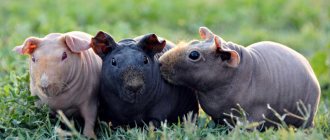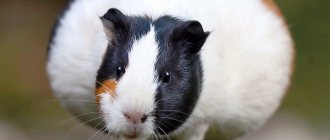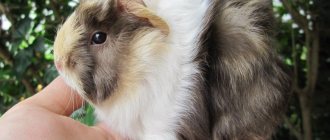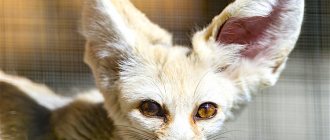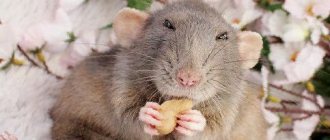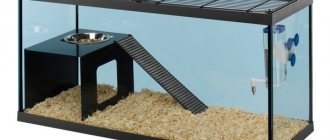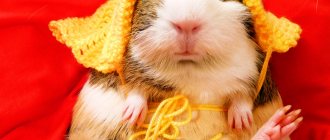A guinea pig is an almost ideal option for a first pet. She:
- Easy to care for
- Easy to maintain
- Clean
- Friendly
But at the same time, the rodent remains a pet that requires care. If you don’t know the basics of keeping a cavi (another name for your animal) and caring for them, you will greatly complicate life for yourself and your pet. There is a lot of useful information for beginning “pig breeders” in the article below.
The guinea pig is the friendliest rodent.
How many pigs do you need to be completely happy?
Keeping a guinea pig alone should be considered animal cruelty. A lonely pig moves little, eats more and develops behavioral disorders. Such animals even live significantly less than happy relatives in the group.
If you are not ready to keep two pigs, don’t get one. A lonely animal will never be happy; guinea pigs are too determined to communicate with their own kind. After all, in nature these animals live in colonies.
Even if the pig is “friends” with the owner, with the cat, with the dog, communication with another pig will not replace it. It’s worth watching the animals that live together to understand the difference: they play, groom each other’s fur, sleep in each other’s arms, and chirp.
It’s not too late to add relatives to an adult guinea pig. Some owners don't do this to keep their pet tame and friendly. Or more correctly, painfully dependent on rare human attention. There is no need for selfishness: pigs in a group are much more interesting to watch, and they will remain tame if you devote time to them every day.
Features of care during the breeding season
During the breeding season, guinea pigs become especially active. Therefore, at this time you need to pay special attention to their nutrition, and the main focus should be on fresh grass, fruits and vegetables. During the breeding season, it is not recommended to bathe pets or subject them to other cosmetic procedures, and to disturb them by direct contact as little as possible. Otherwise, their care during this period is no different from the traditional one.
Find out also whether you can be allergic to a guinea pig.
How much space does a guinea pig take up: cage arrangement
If you want to get a pig because there is not enough space in your apartment for a cat or dog, give up this idea. A guinea pig takes up more space than the largest cat and makes more noise.
You cannot keep a pig in:
- Aquarium/terrarium;
- Closed cage "dune";
- Hamster cage;
- Multi-tiered high cage for birds, chinchillas, rats.
The ideal option is an enclosure, but it is rarely built in an apartment. The cage should be one-story, 120-150 cm in length to accommodate 2-3 animals. The bigger the better, but even a spacious cage does not satisfy the need for movement, and rodents need to be allowed out of the cage for a walk (6 hours a day).
It may seem that a large cage requires a lot of filler, but in fact this is not the case: you will have to change the bedding less often than in a small cage. Bedding options:
- Paper filler;
- Wood or corn pellets combined with sawdust;
- Sawdust.
The filler should be applied in a thick layer (5 cm), changing as it gets dirty. Under it, on the bottom, you can lay an absorbent diaper. Abroad, fleece fabric is often placed on top of the filling. Fleece allows urine to flow downwards, drying instantly, and solid feces are easy to clean up. This type of bedding needs to be washed regularly.
You cannot keep your pig on a wire rack so that the excrement falls down. The grill damages the paws, causing pododermatitis.
Tunnels, houses, bridges made of ceramics or wood are placed in the cage. There are special toys for pigs - pipes made of hay, wicker balls made of straw. You can hang fabric hammocks or set up beds, but they will have to be washed often.
Prohibited:
- wheel (any size);
- walking ball;
- plastic things.
How to take care of your teeth
Guinea pigs, like other rodents, have incisors that grow throughout their lives, and to prevent them from causing health problems and injuries, they must be constantly ground down. Usually pets do an excellent job of this task without outside help. You only need to provide the animal with everything it needs: hay, grass, hard vegetables, delicacies-spikelets on a solid base. There must be chalk or mineral stone in the rodent's cage. It is needed not only for grinding teeth, but is also a source of calcium, a microelement necessary for strong bones and teeth, and good health in general.
You can also offer the rodent branches of fruit trees, peeled from the bark: apple trees, apricots, pears, etc. For many pets, gnawing on sticks is also an exciting pastime.
If you give your guinea pig only soft food, its teeth will begin to grow rapidly and will interfere with eating and hygiene. If this happens, contact the clinic. Veterinarians will trim your pet's teeth to the desired length and tell you how to avoid this problem in the future.
What to feed your guinea pig
Basic rule: food is given without restriction. Pigs eat all the time! The basis of the diet is good quality hay, and in summer – grass. Hay is placed in the cage daily, removing yesterday's hay. Hay is needed around the clock, even if you feed green grass.
In addition to hay, an adult pig is given 150-300 g of vegetables and herbs per day, dividing the portion into several doses to avoid digestive upset. In summer they provide fresh branches with leaves.
Guinea pigs are not hamsters and do not eat grain. They do not need to be given industrial dry food at all, unless we are talking about young animals or pregnant females. When it is necessary to gain weight or increase the caloric content of the diet for another reason, food is given, but not ad libitum. The food should be for guinea pigs.
Additional treats:
- Herb seeds: fennel, dill, anise, dandelion, fescue, amaranth.
- Flaxseed or non-roasted sunflower seeds, but not all the time.
- Pet stores offer pressed hay baskets and dried plant roots (dandelion).
Fresh water is poured into a heavy ceramic bowl, and if an automatic drinking bowl is used, it is hung at muzzle level so that the pig does not have to lift its head.
Don't give pigs:
- Products of animal origin, including those containing milk.
- Sweet foods: chocolate, honey, sugar, confectionery, dried fruits, store-bought treats for rodents.
- Stone fruits (peaches, apricots, plums, cherries) and exotic (pineapple, banana, citruses).
- Plants that cause fermentation: legumes, cabbage.
- Onions, radishes, radishes, rhubarb.
- Potato.
- Cereals (rice, buckwheat and others).
- Flour (baked goods, pasta).
Drinking regime and nutrition
It is more convenient to feed a guinea pig with ready-made concentrated food, at the rate of 20 g per kilogram of animal weight. If you give crackers, white bread or crispbread as a treat, you should know that such food is part of the finished food. Therefore, it must be given in accordance with the permissible volume.
It is worth adding 50 grams of succulent feed and fresh hay to the finished concentrated mixture. This type of feeding allows you to maintain the pig’s health at a high level, since all food has a balanced composition and is rich in vitamins and minerals.
Water is of great importance for rodents. Therefore, it is worth washing the sippy cup every day and pouring fresh, clean water. As vitamins, you can add ascorbic acid to the sippy cup at the rate of 30 ml per 100 ml of liquid. Vitamin C solution can be obtained from a veterinary clinic or pharmacy.
Cons of guinea pigs: 7 fly in the ointment
There is nothing worse than disappointment from a pet. A responsible person will continue to care for the animal, but these responsibilities will not bring joy. When such an animal is gone, the owner will feel both shame and relief, but not sadness. An irresponsible person will simply get rid of an inconvenient pet, and it’s good if he finds good hands for it and does not throw it in the trash.
Before getting a guinea pig, you need to learn about the characteristics of these animals, which not everyone will like:
They make a lot of noise
Guinea pigs not only constantly chew on something, they love to dig into the litter and run around the cage. And they are capable of making a huge number of sounds. Pigs whistle shrilly, squeak, squeal, grumble, chirp, and grind their teeth.
Owners find begging to be a particularly annoying habit. As soon as you slam the refrigerator door or walk past the cage, the pig starts screaming, demanding attention or a treat.
If there are several pets, then they will talk to each other out loud, whistling about something of their own. Talkativeness is the main difference between pigs and other rodents and rabbits.
They litter and get dirty
Guinea pigs love to dig around the bedding, scattering sawdust, hay, food and their own poop around the cage. Daily housekeeping will be required to keep the room clean. In addition to cleaning around the cage, you need to regularly change the filler.
It is impossible to train a guinea pig to a litter box; it eats and poops constantly. Therefore, when you release an animal for a walk, expect to find traces of its activity everywhere.
They are afraid of people, but cannot stand loneliness
At the genetic level, the pig suspects that everyone wants to eat it. Despite the fact that these animals are not aggressive, you should not expect friendliness, trust and a desire to communicate from them either. You will have to spend time accustoming the pig to your hands. A pet can be wary of people for a long time, hiding in the house every time they try to pick it up.
However, under no circumstances should you leave the pig alone. They literally waste away and die of boredom. Ideally, you need communication with relatives. That is, in order for the pig to be happy, you must purchase two or more same-sex animals and paw them less, watching the idyll from afar.
May cause allergies
If one of your family members is allergic to cats or other animals or prone to asthma, you cannot hope that they will not be allergic to a rodent. You can check the reaction to an allergen in guinea pigs in the laboratory, or even more reliably - talk to friends or a breeder for some time with the animals.
Not only the pigs themselves can irritate the respiratory tract, but also dust from sawdust and hay, which must be present in the cage 24 hours a day.
Expensive veterinary care
These rodents have fragile health and are difficult to treat. Infectious diseases in almost 100% of cases end in death, a draft threatens pneumonia, open sunlight - heat stroke. Most often, pigs get sick from improper feeding: forbidden food causes bloating, diarrhea, and poisoning.
An ordinary veterinarian is unlikely to be able to help: the body of guinea pigs is fundamentally different from that of cats and dogs. Find out in advance whether there is a rodent specialist in your city - a rodentologist (ratologist). If not, contact experienced guinea pig breeders.
Seeing a rodentologist is an expensive pleasure. The most common reason for contacting such a specialist is the pathological growth of teeth in mumps (not only the incisors, but also the chewing teeth located deep in the mouth). If teeth are not properly ground down, they are filed under general anesthesia.
Primitive behavior
A guinea pig cannot be trained like a dog. You shouldn't expect too much from them at all. The most sociable rodents can respond to their name, but teaching them commands is a hopeless idea. They also do not take any active part in games, preferring to simply run around the room and chew everything they can get their teeth on.
Coprophagia
Like rabbits, pigs eat their own droppings. Not those solid cylinders that they leave on the litter, but the “primary” liquid, underdigested feces. The pig catches it directly from the anus, curling up into a ball.
For pigs this is absolutely normal and necessary, that’s what Mother Nature came up with. But some people find this feature off-putting.
Summary: whether or not to get a guinea pig
Guinea pigs make wonderful pets. It's a pleasure to watch them. But you shouldn’t have them if:
- You are not ready to adopt two or more pigs at once;
- Get a guinea pig instead of a cat or dog;
- Are you going to keep the animal in a tight cage?
- Spend little time at home.
Guinea pig: keeping and caring for is a troublesome task; many people believe that caring for a cat is much easier. To prevent things from happening, as in the well-known saying “the woman had no worries, the woman bought a piglet,” assess your capabilities in advance.
If you provide a pig company with decent living conditions, the animals will delight you for many years with their cheerfulness, interesting habits and good health. Write in the comments about your pets!
If this article was helpful, please support the author HERE. You can also purchase a fictional story about the work of veterinarians “Dachshund of Fate” using the link.
Bathing a rodent
It is worth bathing animals in case of severe contamination. For example, with diarrhea, when the wool is dirty. If you decide to give the animal a bath, proceed according to the following algorithm:
- Fill a deep bowl with warm water, about 4 cm;
- Place the pig in a bowl of water;
- Wash the rodent gently with baby wash or soap, avoiding getting the ears and head wet;
- After bathing, dry your pig well with a towel;
- At room temperature below 18° C, it is better to dry the wool with a hairdryer.
Rodents with long hair are always dried with a hair dryer. The furry pig is very susceptible to drafts and colds. If not properly cared for, the animal may become ill.

